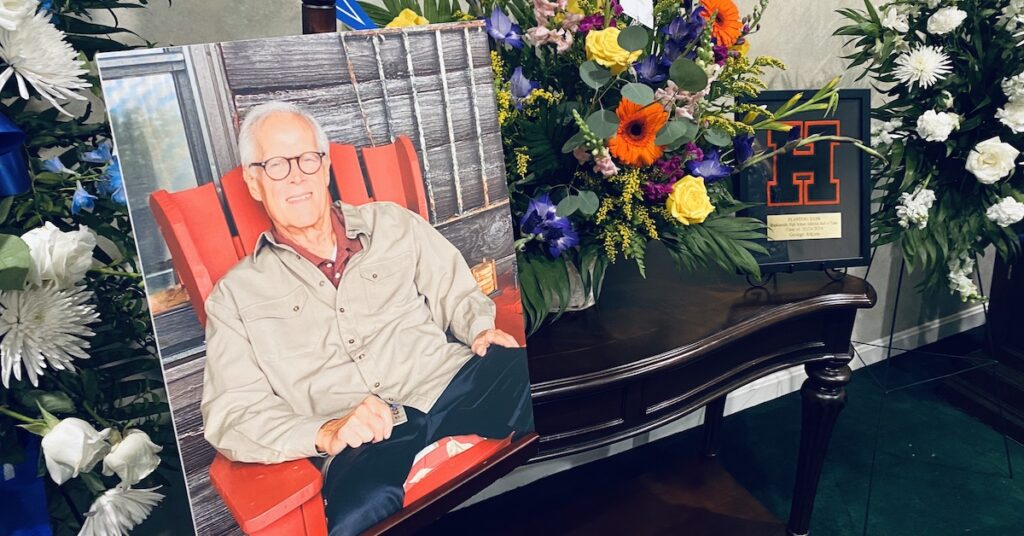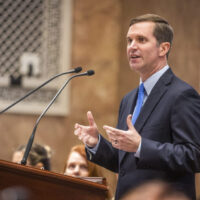George L. Atkins Jr. had served less than four years as Hopkinsville’s mayor when he won election in 1975 to be Kentucky’s state auditor and moved his young family to Lawrenceburg. But Atkins’ connection to Hopkinsville held for decades, and after his death last Sunday at age 82, his children followed through with their father’s plans for a hometown visitation.
For a couple of hours Saturday afternoon, Atkins’ wife, Donna Atkins, and his children, Paige Adams, Ashlee Melendez and George L. “Chip” Atkins III, and their spouses and children, met and reminisced with longtime friends of the family at Hughart, Beard & Giles Funeral Home.

Stories published in the past week have covered Atkins’ basketball prowess at Hopkinsville High School (which earned him a scholarship to play for Adolph Ruff at the University of Kentucky) and his career in Kentucky politics.
Appointed mayor in 1972, he filled the vacancy left by Alfred Naff when Naff departed for a state job. Many saw Atkins’ selection as a ploy to keep Mayor Pro Tem F.E. Whitney, a Black resident who had nearly 20 years on the council, from holding the office until the general election that year. But the concerns did not hurt Atkins politically and he won election that fall to serve out the last year of Naff’s term — and he won again in the 1973 general election.
A column by Kentucky journalist Al Cross, which first ran in Hoptown Chronicle, details Atkins’ bid for governor in 1979. He withdrew from that race and backed the eventual winner, John Y. Brown Jr., who made Atkins his finance secretary and cabinet secretary.
Atkins ran for lieutenant governor in 1983, lost to Steve Beshear, and then became vice president for public affairs at Humana. In that job, he lobbied state lawmakers for legislation that aimed to ease regulations on hospital expansions in Jefferson County. An FBI investigation found that Atkins provided a bribe to a state representative whose support was needed for the so-called Humana bill. After pleading guilty, Atkins was fined $10,000, sentenced to five years of probation and ordered to spend weekends in jail for six months.
Up until now, Atkins’ professional life has been viewed mostly as two large bookends — his rise to mayor at the age of 30 and his fall in the FBI investigation that ended any prospect of a future in politics.
But in his hometown, where many people still casually refer to him as “George L.,” the picture is more nuanced. Some nearly forgotten chapters of his early political work also deserve our attention and remembrance.
The first councilwoman
One of those chapters was announced in a Kentucky New Era story on Aug. 20, 1973, after Atkins asked Fannie Louise Maddux to become the first woman on Hopkinsville City Council. The council unanimously backed the new mayor’s pick to fill a vacancy, and Maddux joined the council.
The newspaper — which initially referred to her as “Mrs. Charles Maddux” rather than using her given name — said the pick of a woman was something of a surprise. But Atkins said female representation was long overdue. (On this Sunday more than 50 years later, I feel like hollering, “Amen, mayor.”)
Atkins told the newspaper, “This feeling has no connection to any women’s liberation movement but is based on recognition that women make up a large percentage of the population.
“They are involved in every facet of community life that is foreign to a businessman. They are personally aware of the needs of our children, the condition of our shopping centers, schools and public facilities and of our libraries and playgrounds. They are aware because they use them daily.”
After serving on the council, Maddux ran successfully for school board. She would eventually also serve on the Prichard Committee for Academic Excellence and she continues today as an advocate for public education.
She has not forgotten George L. Atkins’ decision to seek her out for public office. Nor should we.
Growing the library
Another development during the Atkins administration involved moving the public library from the old Carnegie building on Liberty Street to a larger, remodeled structure on Bethel Street, which is now the Hopkinsville-Christian County Public Library. A city government study that cleared the way for this move and upgrade began shortly after Atkins won the general election in November 1973. The construction work was completed in late 1976 and the new library was dedicated in January 1977.
The blackbird challenge
One of the more challenging — and arguably bizarre — chapters for Atkins as mayor involved the notorious blackbird invasion on Hopkinsville.
Beginning in the early 1970s and continuing for several years, millions of blackbirds, grackles and starlings roosted in pine thickets and other wooded areas of Hopkinsville and Fort Campbell, and in the surrounding countryside.
The birds posed a huge threat to the region’s health and economy. The birds feasted on farm crops and inundated the area with droppings, which in turn released spores that exposed humans to histoplasmosis, a fungal disease affecting lungs, eyes and other organs.
This is where the Atkins story bends in the direction of a personal story for me and my family. During the height of Hopkinsville’s blackbird troubles, my late father, Dr. Frank Pitzer, was a pathologist at Jennie Stuart Hospital and a member of the Christian County Board of Health. Like Atkins, he was often quoted in stories published by news outlets across the country — and, like Atkins, he argued for killing the blackbirds regardless of any cruelty concerns raised by animal activists.
As local officials awaited a court ruling on Fort Campbell’s plan to spray the birds inside the army installation with Tergitol (a chemical that strips protective oils from bird wings and causes them to freeze and die), Atkins told news reporters he was frustrated by New York activists who were attempting to halt the plans.
Atkins, interviewed by The Associated Press in February 1975, said that if Fort Campbell wasn’t allowed to kill the birds, then New York City ought to halt its rat-killing program.
“This shows the ludicrousness of the whole system that allows people far removed from a problem to control action taken on that problem,” Atkins said. “It’s not supposed to work this way. We have people in New York controlling the destiny of Christian County and Hopkinsville.”
Tergitol never materialized as a real solution to Hopkinsville’s bird roosts. Instead, officials opted to bulldoze trees where it was estimated millions of birds roosted, mainly along Pardue Lane.
During much of his term, Atkins was advocating for the health of local residents affected by the birds, and he spoke on behalf of Christian County farmers outside the city limits who suffered financial losses.
A shared street
The blackbird saga doesn’t fully explain my family’s connection to Atkins. His was the first family I remember meeting in our new neighborhood, the Givens Addition, when my parents, my sister and I moved here from Memphis in the fall of 1966. I was 4 years old, and our brick ranch house was across the street from the home of George L., his first wife Sue Ann, and their daughters Paige and Ashlee. (Chip was born a few years later.)
Maybe this is what happens when you practice journalism in your hometown for 35 years: One day you are 6 or 7 years old, crouched in the back of a station wagon the size of a boat. You are with two little friends from across the street, and their father is driving you through the neighborhood. You are pretending to not be there. The father is a good sport and plays along, asking aloud where the girls went. He pretends to not hear the giggles erupting behind him.
Then, a few decades pass and you are on the phone interviewing the same father, George L. Atkins Jr., about a time in high school when he and a few buddies ran to help a woman screaming for her life from an alley behind his childhood home. He will tell you how that woman’s murder (still unsolved today) affected the town in the fall of 1958.
Then fast forward another 20 some years, and you are standing in a funeral parlor reminiscing with his daughters, your childhood playmates, about families and change and the way time has flown for all of us.
Saying goodbye
Dozens of people turned out for Saturday’s visitation with the Atkins family. They talked about George L. as the kid he was when they were growing up in Hopkinsville. They remembered his parents and the family business, Atkins Dairy, and how the elder George L. made early morning, back porch deliveries of milk all over town.
I heard them speak about ballgames, high school mischief, Sub Deb dances, old and new houses, old Hoptown, teachers they loved (and didn’t), dating, family recipes and friends long gone.
It was a proper send-off.
Jennifer P. Brown is co-founder, publisher and editor of Hoptown Chronicle. You can reach her at editor@hoptownchronicle.org. She spent 30 years as a reporter and editor at the Kentucky New Era. She is a co-chair of the national advisory board to the Institute for Rural Journalism and Community Issues, governing board president for the Kentucky Historical Society, and co-founder of the Kentucky Open Government Coalition.





